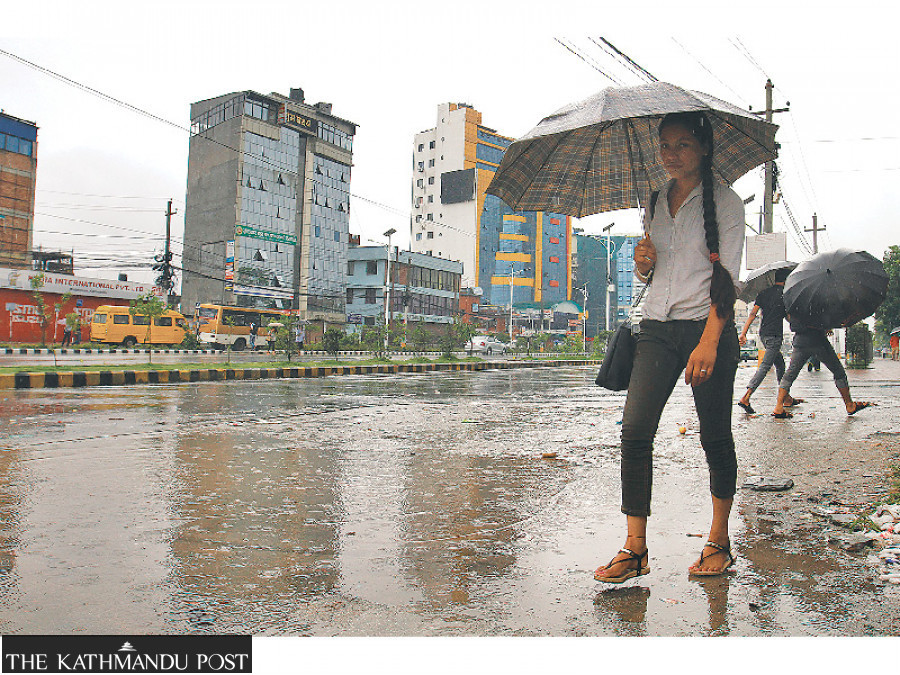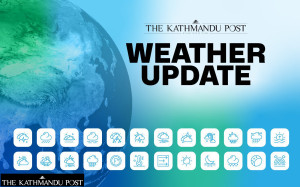Weather
Light to moderate rainfall likely until Saturday
There is a chance of extremely heavy rainfall in a few places in Gandaki, Lumbini, and Sudurpaschim provinces, as well as one to two places in the east.
Post Report
An effect of a low-pressure system developed over the Bay of Bengal will cause light to moderate rainfall throughout the country from Thursday to Saturday.
According to the Meteorological Forecasting Division of the Department of Hydrology and Meteorology, a few places in Gandaki, Lumbini, and Sudurpaschim provinces and a couple of regions in Koshi Province could also witness extremely heavy rainfall.
“Moisture coming from the Bay of Bengal caused partial to general cloudy conditions on Tuesday in many places throughout the country, and some places of the western part of Lumbini Province and Tarai region of Sudurpaschim Province witnessed light to moderate rainfall with a thunderstorm,” said Pratibha Manandhar, a senior meteorologist. “A few places in all provinces will witness light to moderate rainfall and thunderstorms on Wednesday as well.”
The Met Office said there is a chance of heavy rainfall in a few places of Sudurpaschim and one to two places of Koshi, Bagmati, Gandaki, and Lumbini Province on Wednesday. One to two places of Sudurpaschim Province could witness extremely heavy rainfall also.
“The weather will remain general to completely cloudy from Thursday to Saturday, and most places across the country will witness light to moderate rainfall,” reads the special bulletin issued by the division.
Red alerts have been issued in Ilam and Panchthar of Koshi Province; Tanahun, Lamjung, Kaski, Syangja, Parbat, Baglung and Myagdi of Gandaki Province; Palpa, Gulmi, Arghakhanchi, Pyuthan, Rukum East, Rolpa, Dang, Bardia and Banke of Lumbini Province; Surkhet, Salyan, Rukum-West, Jajarkot, Dailekh of Karnali Province; and Kailali, Kanchanpur, Dadeldhura and Doti districts of Sudurpaschim Province.
According to Met officials, a red warning means looming extreme weather conditions. Excessive rainfall, floods, landslides, and inundation will likely cause widespread damage. For the general public, it is a message to keep themselves and others safe from the extreme weather consequences and not to travel in risky zones.
An orange alert has been issued in 42 districts, including all districts of Bagmati Province.
An orange warning also means moderate risks. Experts say severe situations due to extreme weather events are very likely in the districts. For the general public, it is a message to prepare plans for potential emergencies. As the probability of extreme weather events is high, people are also requested not to travel in risky zones—landslide-prone areas and riverbanks, among others.
The department has cautioned the public about risks of land erosion, debris flow and inundation in urban areas and in the Tarai.
“Everyday life, agriculture, health, tourism, road and air transport could also be affected,” the bulletin stated.
The monsoon season in Nepal generally begins on June 13 and ends on September 23. This year, the clouds from the south entered Nepal from the western region on June 10, three days ahead of the usual onset date. Last year, the weather phenomenon started on June 14, a day prior to the normal onset day.
The monsoon season, which delivers around 80 percent of the country’s total annual rainfall, generally lasts 105 days. But, in recent years, it has been taking more time to withdraw.
This year, too, monsoon rainfall will be prolonged by at least five days. “We cannot rule out rainfall during Dashain,” said Manandhar.
As predicted before the onset of monsoon, Nepal recorded above-average rainfall this season.
According to the Met office data, the country received 1,514.5 millimetres of rainfall as of Tuesday since the monsoon entered on June 10, 102.4 percent—2.4 percent above the average monsoon rainfall.
Normally, the country receives an average of 1,472 mm of rainfall in the four months—June, July, August, and September. Last year, however, the country witnessed only 1,303 mm of rainfall in the season, 88.5 percent of the average.
Nepal is one of the world’s most vulnerable countries to the climate crisis and has witnessed multiple extreme weather events over the past decade and a half.
Evidence suggests that maximum temperatures in Nepal are rising faster, at 0.056 degrees Celsius a year, compared to the annual global average rise of 0.03 degrees Celsius.
Experts say extreme weather events—excessive rainfall in a short period, continuous rains for several days after the monsoon, dry spells, droughts, below-average precipitation, and above-normal winter temperatures—have become more frequent in Nepal.




 11.12°C Kathmandu
11.12°C Kathmandu





